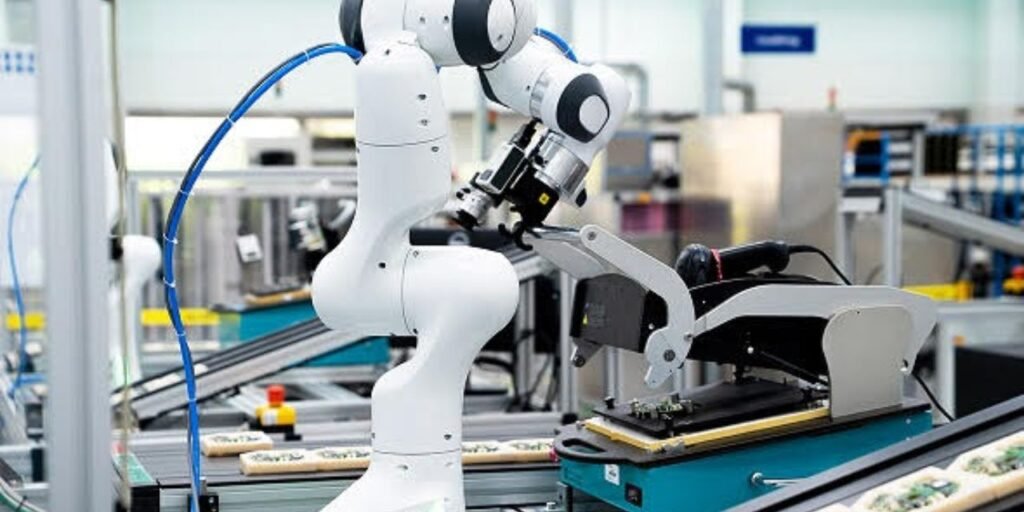
Title- Collaborative Robots: Shaping the Future of Automation
Collaborative robots, or cobots, have revolutionized the way industries approach automation. Unlike traditional robots, which require safety cages and are separated from human workers, cobots are designed to work safely alongside humans. This fundamental shift allows businesses of all sizes to harness automation in a flexible, cost-effective, and scalable manner.
As industries move toward digital transformation and smart manufacturing (Industry 4.0), cobots are emerging as a key driver of this change, especially for small and medium-sized enterprises (SMEs) that previously found full automation systems out of reach.
Market Growth and Size
The collaborative robot market has witnessed rapid growth in the past few years, and projections suggest it will continue to expand significantly. In 2023, the global market size for cobots was valued at approximately $1.5 billion, with a compound annual growth rate (CAGR) of over 30% anticipated through 2030.
This rise is driven by various factors: the increasing demand for automation across industries, advancements in robotic technology, and the cost-effectiveness of cobots. In industries like manufacturing, healthcare, logistics, and electronics, cobots are helping to optimize production lines, reduce human error, and enhance overall operational efficiency.
Market Segmentation
The collaborative robot market can be segmented based on payload capacity, industries served, and applications.
By Payload Capacity: Cobots are categorized into low (up to 5kg), medium (5-10kg), and heavy payloads (above 10kg). Each category serves different purposes, from light assembly tasks to heavy-duty material handling.
By Industry: The automotive sector has been a dominant player, utilizing cobots for assembly, painting, and quality inspection. Meanwhile, industries like electronics, healthcare, and logistics are increasingly adopting cobots for tasks like precision assembly, surgical assistance, and warehouse automation.
By Application: Cobots are being used for assembly, material handling, packaging, palletizing, and quality inspection. Their versatility makes them ideal for environments that require frequent changes in production processes.
Regional Insights
Regionally, Europe leads the global cobot market, thanks to its strong industrial base and early adoption of robotics in countries like Germany and Denmark. North America follows closely, with increased demand from the automotive, electronics, and healthcare sectors. Meanwhile, the Asia-Pacific region is experiencing the fastest growth, particularly in countries like China, Japan, and South Korea, where manufacturing and logistics are key drivers.
Emerging markets in Latin America and the Middle East are also seeing rising interest in collaborative robots, spurred by the need to modernize production processes and enhance competitiveness on the global stage.
Key Market Drivers and Challenges
The key drivers propelling the collaborative robot market include:
Labor Shortages: Many industries are struggling with labor shortages, especially in jobs that require repetitive tasks or harsh environments. Cobots can bridge the gap, performing these tasks with high precision.
Flexibility and Cost Efficiency: Cobots are more flexible than traditional robots, with easy reprogramming and redeployment options, making them ideal for short-run production and dynamic environments.
Safety and Human-Cobot Interaction: Built-in sensors and safety features allow cobots to operate in close proximity to human workers without the need for fencing or barriers, improving workplace safety.
However, the market faces several challenges:
Initial Investment Costs: Although cobots are more affordable than traditional robots, the upfront costs, especially for smaller businesses, can still be a barrier.
Technical Expertise: Programming and maintaining cobots require skilled personnel, which can be challenging for industries with limited access to technical talent.
Technological Advancements in Cobots
Recent advancements in AI, machine learning, and sensors have greatly enhanced the performance of cobots. AI allows cobots to learn from human operators and improve task efficiency over time. Meanwhile, advancements in sensors have made cobots more adaptable and precise, ensuring higher safety standards and improved human-robot collaboration.
The integration of Internet of Things (IoT) technology has also allowed cobots to work in connected environments, enabling better data collection, real-time monitoring, and seamless integration into smart factories.
Future Trends and Outlook
The future of collaborative robots is full of exciting possibilities. Here are some emerging trends:
Enhanced Mobility: Cobots are becoming more mobile, allowing them to move freely across production floors or even collaborate in different sections of the workspace.
AI and Machine Learning: More cobots will incorporate AI and machine learning capabilities, enabling them to adapt to complex tasks with minimal human intervention.
Healthcare Applications: The healthcare sector is seeing growing adoption of cobots for tasks such as surgery assistance, rehabilitation, and patient care.
The market for cobots is expected to broaden as more industries realize their potential. Industries such as agriculture, food processing, and retail are likely to explore the capabilities of cobots for tasks that require precision, speed, and repetitive motion.
Key Players in the Collaborative Robot Market : ABB, KUKA AG, FANUC CORPORATION, Kawasaki Heavy Industries Ltd
Collaborative robots are reshaping the landscape of industrial automation, making it accessible to more businesses than ever before. Their ease of use, adaptability, and safety features make them an essential tool in modern manufacturing, healthcare, and beyond.
As cobot technology continues to evolve, we can expect to see a broader adoption across industries, further accelerating the shift toward smarter, more efficient production systems. In this new era of automation, cobots are poised to be key enablers of productivity, innovation, and sustainable growth.
